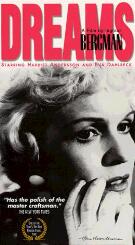Thinking About the Movies: Ingmar Bergman's Dreams
by dave heaton
 Given how impossible it is for anyone to really got a handle on the scope of film history (in one country even, not to mention the world), it makes sense that as film discoverers searching through the films of the past we tend to find ourselves drawn towards the films that are held in the highest regard. Yet more often than not, when I'm catching up with a director's body of work, I find that I enjoy some of the lesser-known films as much or more than the best-known ones. The perfect example: a few weeks back I watched four Ingmar Bergman films for the first time - two were earlier films that I wasn't familiar with (Monika and Dreams) and two were "classics" that I felt guilty for not having seen before (Wild Strawberries and Persona). While I enjoyed all four, the film that has stuck with me the most since I watched it is Bergman's 1955 film Dreams, generally considered a minor work in his overall filmography. While the film may lack the visual complexity of Persona or the big, life and death issues of Wild Strawberries, it is such a beautifully constructed and emotionally powerful film - with a personal, intimate atmosphere in terms of both visuals and the plot - that to me it will be impossible to forget.
Given how impossible it is for anyone to really got a handle on the scope of film history (in one country even, not to mention the world), it makes sense that as film discoverers searching through the films of the past we tend to find ourselves drawn towards the films that are held in the highest regard. Yet more often than not, when I'm catching up with a director's body of work, I find that I enjoy some of the lesser-known films as much or more than the best-known ones. The perfect example: a few weeks back I watched four Ingmar Bergman films for the first time - two were earlier films that I wasn't familiar with (Monika and Dreams) and two were "classics" that I felt guilty for not having seen before (Wild Strawberries and Persona). While I enjoyed all four, the film that has stuck with me the most since I watched it is Bergman's 1955 film Dreams, generally considered a minor work in his overall filmography. While the film may lack the visual complexity of Persona or the big, life and death issues of Wild Strawberries, it is such a beautifully constructed and emotionally powerful film - with a personal, intimate atmosphere in terms of both visuals and the plot - that to me it will be impossible to forget.
Dreams essentially tells two women's stories, both about love, desire, and loneliness. The film offers no spellbinding entwining of the two stories; instead, we have a basic introduction to the characters, followed by one woman's story and then the other's. But both stories are told elegantly if casually, with the actors' presence and honesty elevated by the camera's attention to the details of their faces and of the worlds in which they travel. The two stories achieve no real synchronicity, yet each is equally compelling. The first of the two is a tale of both youthful curiosity and the hardship of aging. In it, a young model on a photo shoot (Harriet Andersson) is courted by a mysterious older man , who showers her with expensive gifts without explaining his intentions or history. The second story is of the model's boss (Eva Dahlbeck), who has arranged this particular photo shoot as a means of confronting her former lover, a married man who broke off their affair to return to his wife and family.
Both stories are simple and at times rather light in tone, yet they contain moments of overwhelming emotional force, where actions, words and faces reveal hidden stories, longings and fears. Bergman uses the camera like a magnifying glass, honing in on insights and details. Perhaps what impresses me most about the film is how strongly it captures faces. In Dreams Bergman and cinematographer Hilding Bladh often seem to want to let faces speak for themselves - so much more is communicated in the actors' expressions and how they are filmed than in the dialogue and plot. At times Dreams achieves the graceful simplicity of the best silent films - not only in the film's masterful opening scene, a set-up for a photo sheet which is nearly free of dialogue - but also in smaller moments where silence and the observant camera speak more clearly than the best-written words likely would have.
Copyright (c) 2005 erasing clouds |
|